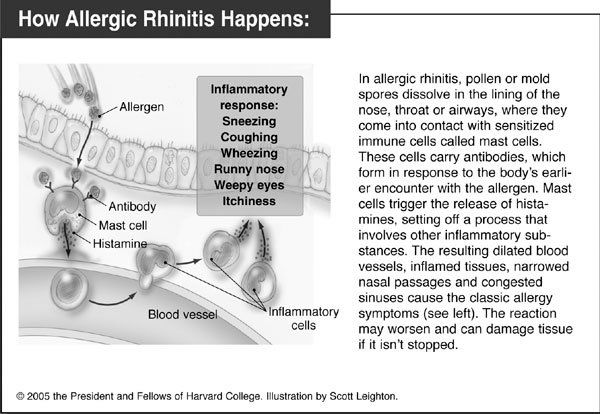Q: My hay fever symptoms have started already. How can I tell
what’s causing my allergy? What medications are best for treating
this problem?
Q: My hay fever symptoms have started already. How can I tell what’s causing my allergy? What medications are best for treating this problem?
A: Many people welcome spring’s balmy weather after being cooped up inside all winter. But if you have hay fever, spring is the beginning of allergy season, and outside can be the worst place to be. Hay fever, officially called “seasonal allergic rhinitis,” is an immune reaction to substances in the outside air. The symptoms – sneezing, runny nose, itchy eyes, stuffy sinuses and tickling throats – aren’t life-threatening, but they can make you miserable. Hay fever can also cause drowsiness, lost work time and difficulty concentrating.
Pollen is by far the most common culprit. Tiny pollen spores from flowering plants blow through the breeze – right into your nose, throat and eyes.
Pollen season starts as early as January in southern states. Further north, it may begin in March or April and run through October.
Pollen from big, showy blooms is rarely a problem because it’s generally too heavy to become airborne. The real troublemakers are plants you might not even think of as producing pollen.
The most common pollen allergens come from:
• Trees such as alder, ash, birch, box elder, cypress, elm, hickory, maple, mulberry, oak, poplar, sycamore, walnut and western red cedar.
• Grasses such as Bermuda, blue grasses, orchard, meadow fescue, rye, sour dock, sweet vernal and timothy.
• Weeds such as burning bush, cockleweed, ragweed, pigweed, Russian thistle, sagebrush and tumbleweed.
Though less notorious than pollen, mold spores can also cause trouble. Outdoor molds, which are active from spring until the first frost, thrive in damp places like rotting wood, leaf piles and compost bins. Among the most common offenders are Alternaria, Cladosporium, Aspergillus and Penicillium.
You can often tell what’s causing your hay fever simply by correlating your symptoms with local pollen and mold counts. Check the pollen count through local media or on the Web page of the American Academy of Allergy, Asthma, and Immunology’s National Allergy Bureau, www.aaaai.org/nab.
The best way to avoid allergic rhinitis is to identify the allergen and stay away from it. But that’s often easier said than done.
Several medications are available for treating hay fever. Many are newer, safer versions of older drugs. If you can, start taking the medication before the hay fever season starts. This will lower your chances of developing complications such as sinus infections and blocked ears. Choose an allergy medications based on your specific symptoms. Medical treatments include:
• Antihistamines: These medications block the action of histamine, a major cause of allergy symptoms. Antihistamines are often recommended first because many are available over-the-counter.
Older drugs such as Benadryl may make you drowsy. That’s somewhat less likely with the newer generation of less-sedating or non-sedating such as prescription Allegra and nonprescription Claritin. These drugs can also be taken once a day, instead of every four to six hours.
Antihistamines work well for sneezing, runny nose, and itchy, watery eyes, but not as well as nasal corticosteroids (discussed below) for congestion. Other examples of less-sedating, prescription antihistamines include Semprex-D, Zyrtec and Astelin nasal spray.
• Decongestants: If your nose has been stuffed up for a few days, you may need a decongestant. Available in oral and nasal-spray forms, decongestant drugs work on the nervous system to narrow blood vessels, helping to dry up secretions and clear congestion. They can cause dry mouth, nervousness, insomnia, rapid heartbeat, increased blood pressure and damage to the lining of the nose, so they shouldn’t be used for more than a few days. Some common over-the-counter decongestants include Actifed, Afrin, Allerest, Dristan, Neo-Synephrine and Sudafed. Others are combined with painkillers (Advil Cold and Sinus, Motrin IB Sinus, others) or with antihistamines (Benadryl Allergy and Sinus, Dimetapp and others).
• Nasal Coritcosteroids: Anti-inflammatory nasal sprays are the most effective medical treatment for allergic rhinitis. They help turn off the immune reaction in the nasal passages and provide sustained relief.
Nasal corticosteroids can irritate the nasal membranes, but they don’t have the troubling side effects associated with oral, injected or inhaled steroids, such as bone loss and weight gain. Examples include beclomethasone (Beconase), budesonide (Rhinocort), flunisolide (Nasarel), fluticasone (Flonase), mometasone (Nasonex) and triamcinolone (Nasacort), which are all prescription-only.
• Mast Cell Stabilizers: These drugs reduce swelling and secretions by interfering with the release of certain chemicals from mast cells (see accompanying illustration). They’re very safe but not as effective as nasal corticosteroids. Examples include cromolyn sodium (Nasalcrom) nasal spray, which is available over-the-counter and lodoxamide (Alomide) eye drops and nedocromil (Alocril) eye drops, which are prescription-only.
There’s no way to stop the coming of spring, but there are a growing number of effective treatments to stop the irritation caused by allergies.
Submit questions to the Harvard Medical School Adviser at www.health.harvard.edu/adviser. Unfortunately, personal responses are not possible.












